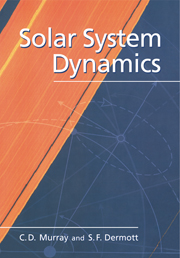Book contents
- Frontmatter
- Contents
- Preface
- 1 Structure of the Solar System
- 2 The Two-Body Problem
- 3 The Restricted Three-Body Problem
- 4 Tides, Rotation, and Shape
- 5 Spin–Orbit Coupling
- 6 The Disturbing Function
- 7 Secular Perturbations
- 8 Resonant Perturbations
- 9 Chaos and Long-Term Evolution
- 10 Planetary Rings
- Appendix A Solar System Data
- Appendix B Expansion of the Disturbing Function
- References
- Index
4 - Tides, Rotation, and Shape
Published online by Cambridge University Press: 05 June 2012
- Frontmatter
- Contents
- Preface
- 1 Structure of the Solar System
- 2 The Two-Body Problem
- 3 The Restricted Three-Body Problem
- 4 Tides, Rotation, and Shape
- 5 Spin–Orbit Coupling
- 6 The Disturbing Function
- 7 Secular Perturbations
- 8 Resonant Perturbations
- 9 Chaos and Long-Term Evolution
- 10 Planetary Rings
- Appendix A Solar System Data
- Appendix B Expansion of the Disturbing Function
- References
- Index
Summary
What fates impose, that men must needs abide;
It boots not to resist both wind and tide.
William Shakespeare, Henry VI (3), IV, iiiIntroduction
So far we have considered all objects as being point masses with no physical dimensions. Since this is evidently not the case for real bodies, we must now consider the effects of the application of universal gravitation to the matter that forms the bodies of the solar system. A tide is raised on one body by another because of the effect of the gravitational gradient or the variation of the gravitational force across the body. For example, if we consider the tide raised on a planet by an orbiting satellite, the force experienced by the side of the planet facing the satellite is stronger than that experienced by the far side of the planet. Since none of the bodies that make up the solar system is perfectly rigid, there will be a distortion that gives rise to a tidal bulge.
The magnitude of the tidal bulge on a body is determined in part by its internal density distribution and thus, in principle, a measurement of the tidal amplitude could lead to a determination of the internal structure. Such measurements are not possible for any of the planets in the solar system other than the Earth.
- Type
- Chapter
- Information
- Solar System Dynamics , pp. 130 - 188Publisher: Cambridge University PressPrint publication year: 2000
- 1
- Cited by

